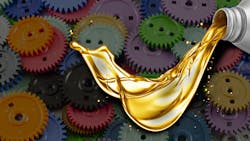This article was originally published Aug. 1, 2000. It was updated Jan. 31, 2023.
READ MORE: Keeping Lubricants Safe from Water
Many engineers and maintenance personnel mistakenly believe plastic components either require special plastic lubricants or no lubricants at all. In fact, these parts need to be lubricated to reduce friction and wear and increase component life, just like metal parts.
Tests show lubricated plastic sliding bearings last up to five times as long as nonlubricated ones. Even self-lubricating plastic materials, such as PTFE (Teflon), benefit from lubrication. At speeds over 1 rpm, friction on nonlubricated Teflon sleeve bearings increase; it decreases for lubricated bearings.
The most important criteria for choosing the right lubricant for plastic parts is that it is compatible with the specific plastic. That compatibility must be verified under all anticipated loads, speeds, and environments the part might be exposed to. If the lubricant and plastic are incompatible, it can cause stress cracking and failure of the part.
READ MORE: Tribology by Design: A Revolution in Tribology
Factors that contribute to compatibility include the lubricant’s chemistry (base oil, thickeners, and additives), viscosity, and resistance to aging. Let’s take closer look at these factors.
Chemistry. Silicone-based lubricants such as PFAE, most synthetic hydrocarbons (SHC or PAO) and mineral oils work well with plastics. Lubricants based on esters or polyglycols generally do not, although there are exceptions depending on the type of plastic.
If a lubricant’s formulation is incompatible with a plastic part, the part can lose dimensional stability and structural integrity, as well as become discolored.
To check for compatibility, manufacturers must determine the plastic’s physical properties including volume, weight, elongation, strength, and hardness before and after exposure to the lubricant. Manufacturers set limits on how much change is allowed after exposure, which is typically 7 to 10%. It’s important that these tests and exposures reflect worst-case conditions. Lubricants and plastics are more prone to changes at higher temperatures or in adverse environments, especially with high dynamic loads.
READ MORE: Lubricants for Electric Cars and Trucks
Additives can make a lubricant to react with plastic. Solid additives, such as graphite or molybdenum disulfide (moly), for example, can penetrate and weaken plastic components. So, these additives should be avoided when dealing with plastic gears and bearings. PTFE solid additives, on the other hand, are useful in certain cases such as lowering startup friction or providing dry lubrication.
Extreme pressure (EP) additives used in lubricants for metal parts are not recommended for plastic parts. And large amounts of corrosion protection and metal deactivator additives used with metal parts are just not needed for plastics.
Viscosity/NLGI grade. High-viscosity oils, generally those with viscosities rated at ISO VG 100 or higher, are less likely to penetrate the plastic and degrades it. Greases with an NLGI of 1 or 0 reduce friction and grease-induced noise (grease slap). NGLI is a measure of how hard the grease is. 0 to 1 indicates the grease is fluid or semi-fluid.
Aging resistance. Outgassing byproducts of plastic, such as formaldehyde and styrene, accelerate aging in lubricants. And as lubricants age they, in turn, are more likely to degrade plastics. So, long-term plastic applications do best with synthetic lubricants, which have a high aging resistance.
Overall, mineral-oil-based lubricants are good candidates for lubricating plastics because they don’t attack most plastic materials and offer excellent performance for the dollar in general plastic applications. However, as machines move to higher operating speeds, higher temperatures, and longer operations, companies prefer synthetic lubricants, such as hydrocarbon (PAO) types, for plastic bearings and gears. PAO’s high aging resistances are compatible with most plastics, and can provide long-term lubrication at temperatures from −60 to 320°F.
READ MORE: Why Maintenance of Water Glycol Hydraulic Fluids Makes All the Difference
PFAE lubricants are some of the most compatible, even with hard-to match plastics. Like PAO oils, they have a good balance between adhesion and wetting plastic surfaces. Their most widely sought-after characteristic is their ability to handle temperatures up to 500°F. Because of their high cost, use PFAE oils only where necessary.
Silicone-based lubricants also have excellent compatibility. They are well suited for low load applications and can withstand temperatures from −90 to 425°F).
Richard Gianattasio was a technical engineer at Kluber Lubrication North America Inc., Londonderry, N.H., when this article was first published.
